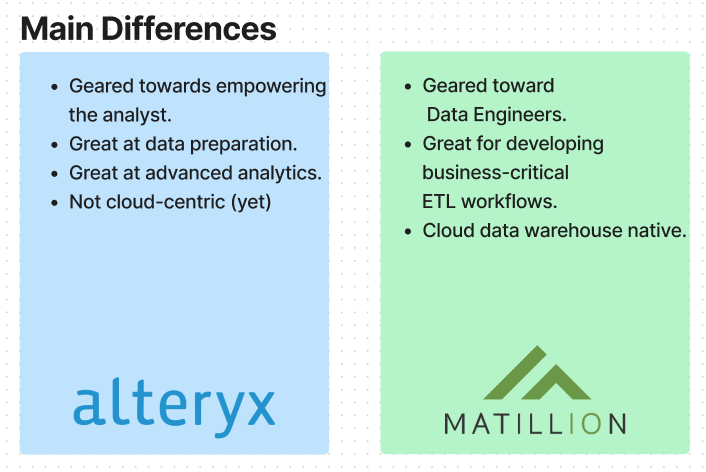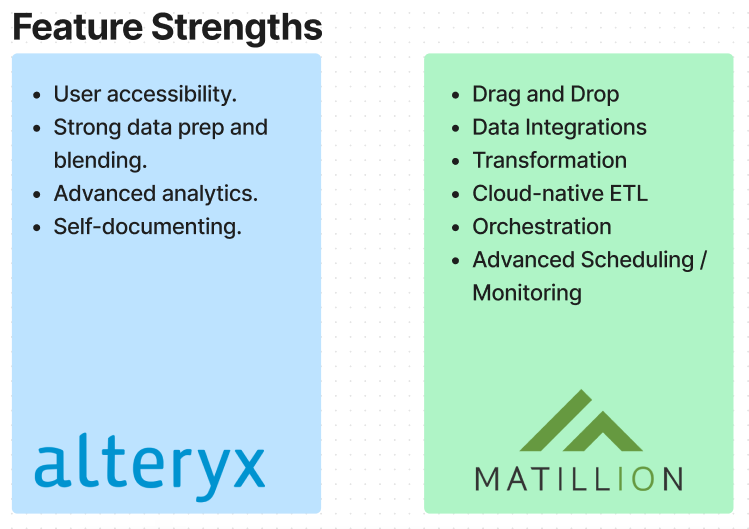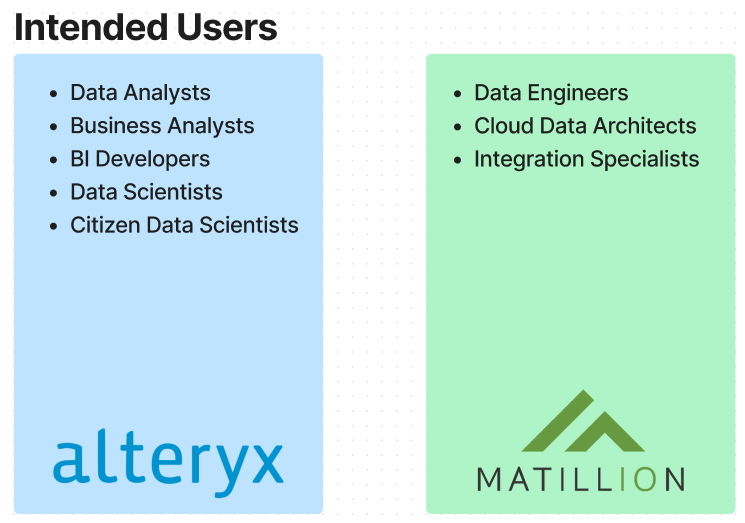What are the differences or similarities between Matillion and Alteryx Designer?
Both Matillion and Alteryx are popular low-code/no-code tools that help with data transformation and integration, so it’s no surprise we have to clarify these two tools with clients from time to time.
While on the surface these visual, drag-and-drop data tools appear similar, they differ greatly in their architecture and purpose. Both tools have their strengths and even overlaps, but tend to differ in their intended uses.
To help explain further, we brought together minds from both the Data Practice and the Analytics Practice at InterWorks to help answer this question.
Let’s breakdown components of each tool.
Overview
Matillion
Matillion is a low-code, GUI-based data orchestration and transformation tool for cloud data platforms. Using Matillion, you can orchestrate the ingestion of data from a wide range of sources into your cloud data platform and build data pipelines to clean, prepare and transform this data. Unlike other platforms, Matillion allows you to conduct all of your data transformation and ingestion operations in one centralized place.
Alteryx
Alteryx Designer is designed to empower all users, coders and non-coders alike, to work with data and automate their workflows comfortably. Alteryx is targeted at the non-coder or time-constrained analyst and business user, allowing them to blend, clean and transform data from a large variety of data sources ranging from flat files to data warehouses. Beyond data preparation, Alteryx users can performance advanced analytics, spatial analytics and even some reporting and visualization.
Compared with Matillion, Alteryx Designer is not cloud-native. To develop and author workflows, one must use a desktop application. Publishing and schedule workflows requires Alteryx Server, which is either hosted or on-prem. *We are not including Alteryx Designer Cloud into this analysis, though you can see our initial impression Alteryx Designer Cloud here.

Main Strengths
Matillion:
- Cloud-native: Under the hood, Matillion ETL operates by using the user’s GUI-based inputs to automatically generate and execute the relevant SQL commands for the underlying cloud data platform (Snowflake, Redshift, Azure, Synapse). As a result, data does not pass through Matillion itself and, instead, Matillion leverages the scalability and flexibility of modern cloud data warehouses. This makes Matillion a popular option when choosing an ETL tool as you build your data warehouse.
- Orchestration: Because Matillion is built as a native cloud data warehouse ETL tool, it has important features for creating and maintaining production pipelines, like orchestration, advanced scheduling and monitoring.
- Manage, develop and deploy data pipelines across multiple environments. These environments could be a typical dev/test/UAT/prod style or they could align with a modern DevOps approach with an environment per branch.
Alteryx:
- Data prepping and blending: Alteryx has a very robust set of data preparation tools geared towards data analysts and business users to prepare data from all data sources and file types (including local Excel files), blend them using joins, unions and cleaning the data using a deep library of text manipulation (like regex) or formula-based tools.
- Accessibility: Alteryx provides an intuitive interface and self-service capabilities that enable users with varying levels of technical expertise (from business user to data analyst to data scientist) to perform data preparation or advanced analytics tasks.
- Flexibility: Alteryx provides many data storage options – flat files, relational databases, cloud storage and data warehouses. Output options are meant to accommodate the wide needs of a typical analyst in a business.
- Advanced Analytics / Predictive: Because Alteryx is geared towards analytics, as well as data preparation, Alteryx comes standard with advanced and predictive tools allowing users to perform such analysis as regressions, optimizations and machine learning algorithms. Also included is an industry-best toolkit for manipulating and doing analysis on spatial data.

Intended Users
Who Are the Users of Matillion?
Because of it’s cloud-first architecture and focus on orchestration, Matillion users tend to be data engineers or architects using Matillion to integrate and transform data within cloud data warehouses. Although users tend to be data engineers and architects, the low-code nature would allow business analysts to easily create data pipelines using more than 100 pre-built data source connectors.
Who Are the Users of Alteryx?
Alteryx thrives in heavy self-service environments with capable business analysts. The ease of use, strong data preparation and advanced analytics tooling makes Alteryx popular among data analysts, business analysts and citizen data scientists. Data analysts enjoy the robust set of data preparation and transformation tooling and ability to connect to a wide range of data sources (including spatial data). Business analysts are empowered by applying their deep understanding of business logic and metrics to create data pipelines for analysis or downstream reporting without having to know data engineering or coding. Citizen data scientists use Alteryx to tap into its built in catalog of advanced analytics and data science tooling, such as predictive, spatial, machine learning, optimization and even natural language processing (NLP).

Can You Successfully Deploy Both Alteryx and Matillion?
Yes! While feature lists of both tools give the appearance of strong overlap between tools, their differing architecture and intended use can generally create separate user types (data engineer vs data analyst) within an organization; therefore, it’s possible to have successful deployments of both tools at a given organization.
A likely scenario is finding Matillion used more upstream by architects and engineers to build productive data pipelines. Then, you may find Alteryx used as a “last-mile data” tool, where downstream users such as data analysts and technical business users combine and blend outputs from Matillion (in a data warehouse like Snowflake) with other business data (such as local files or tables in other systems) to further meet reporting or analytics requirements.


